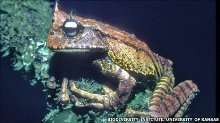Research shows re-evolution of lost teeth in frogs after more than 200 million years

(�鶹��ԺOrg.com) -- A new study by a Stony Brook University professor shows that structures that have been evolutionarily lost for hundreds of millions of years can be regained.
A new study by a Stony Brook University professor shows that structures that have been evolutionarily lost for hundreds of millions of years can be regained. The findings are reported in the journal Evolution , in an article entitled "Re-evolution of lost mandibular teeth in frogs after more than 200 million years, and re-evaluating Dollo’s law".
John J. Wiens, Ph.D., a professor in the Department of Ecology and Evolution, studied the evolution of teeth on the lower jaw in frogs. He combined data from modern frogs, fossils and DNA sequences and utilized new statistical methods to show that frogs lost their teeth on the lower jaw more than 230 million years ago, but that these teeth re-evolved in a single frog species (Gastrotheca guentheri) within the past 20 million years. This means that mandibular teeth were absent for more than 200 million years before re-evolving in Gastrotheca guentheri. Gastrotheca guentheri is a “marsupial” treefrog from Colombia and Ecuador, a species in which females carry their eggs in a pouch on their backs.
The study provides strong evidence against “Dollo’s law,” the idea that a complex trait that is lost during evolution will not re-evolve again. Dollo’s law has been controversial among evolutionary biologists. Some scientists have argued that there are now several examples where complex structures have been lost and regained, such as wings in stick insects, coiling in snail shells, and fingers and toes in lizards. Other scientists have suggested that these examples may be invalid. “The study of teeth in frogs provides very strong evidence for re-evolution of lost structures, and is unusual in showing that this re-evolution can happen after hundreds of millions of years,” Dr. Wiens said.
This study also suggests how a trait can re-evolve after such a long absence, a mechanism that Wiens calls a “loophole” in Dollo’s law. “Even though teeth are absent on the lower jaw in almost all frogs, they are generally present on the upper jaw,” Dr. Wiens said. “So the mechanisms for developing teeth are present in most frogs and did not have to re-evolve in Gastrotheca guentheri in order for teeth to re-appear on the lower jaw.” This type of "loophole" may apply to many other cases in which traits appear to re-evolve, such as in the re-evolution of lost fingers and toes in lizards, he said.
More information: Paper online:
Other recent papers include:
Wiens, J. J., C. A. Kuczynski,T. Townsend, T. W. Reeder, D. G. Mulcahy, and J. W. Sites, Jr. 2010. Combining phylogenomics and fossils in higher-level squamate reptile phylogeny: molecular data change the placement of fossil taxa. Systematic Biology 59:674–688.
Wiens, J. J., J. Sukumaran, R. A. Pyron, and R. M. Brown. 2009. Evolutionary and biogeographic origins of high tropical diversity in Old World frogs (Ranidae). Evolution 63:1217–1231.
Provided by Stony Brook University

















